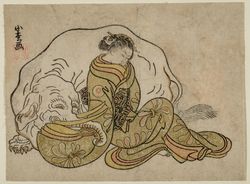Difference between revisions of "Category:Lead white: Ukiyo-e colorant"
| Line 4: | Line 4: | ||
<font size="3">'''[[Lead white]]'''</font> 鉛白(''enpaku''): A white pigment composed of [[lead carbonate, basic|basic lead carbonate]]. Lead white has been prepared synthetically from Classical antiquity by exposing metallic [[lead]] to [[vinegar]] ([[acetic acid]]) vapour. Lead white and [[:Category:Red lead: Ukiyo-e colorant|red lead]] can discolor and darken when exposed to [[Hydrogen sulfide|hydrogen sulfide]]. | <font size="3">'''[[Lead white]]'''</font> 鉛白(''enpaku''): A white pigment composed of [[lead carbonate, basic|basic lead carbonate]]. Lead white has been prepared synthetically from Classical antiquity by exposing metallic [[lead]] to [[vinegar]] ([[acetic acid]]) vapour. Lead white and [[:Category:Red lead: Ukiyo-e colorant|red lead]] can discolor and darken when exposed to [[Hydrogen sulfide|hydrogen sulfide]]. | ||
| − | + | On a print the color white areas is usually unprinted paper, however, sometimes lead white was used to set apart fields of white from the paper's natural tone. More frequently, it has been found mixed with other colorants, in order to lighten a color or lend opacity. Most frequently, it appears to have been mixed with red lead to create a light pink color. Sometimes lead white paint was spattered across the surface of a complete print in order to approximate the appearance of snow or sea spary. Darkening of lead white has been observed in areas where it was printed alone and in mixtures. It is often this discoloration or lead darkening that leads to its preliminary identification of its presence. Unlike red lead, it appears that printers did not intentionally initiate darkening of this color by exposing it to hydrogen sulfide in order to create a special effect. | |
'''For more information see:''' [[Lead white]] | '''For more information see:''' [[Lead white]] | ||
Revision as of 17:32, 15 July 2020
Lead white 鉛白(enpaku): A white pigment composed of basic lead carbonate. Lead white has been prepared synthetically from Classical antiquity by exposing metallic Lead to Vinegar (Acetic acid) vapour. Lead white and red lead can discolor and darken when exposed to Hydrogen sulfide.
On a print the color white areas is usually unprinted paper, however, sometimes lead white was used to set apart fields of white from the paper's natural tone. More frequently, it has been found mixed with other colorants, in order to lighten a color or lend opacity. Most frequently, it appears to have been mixed with red lead to create a light pink color. Sometimes lead white paint was spattered across the surface of a complete print in order to approximate the appearance of snow or sea spary. Darkening of lead white has been observed in areas where it was printed alone and in mixtures. It is often this discoloration or lead darkening that leads to its preliminary identification of its presence. Unlike red lead, it appears that printers did not intentionally initiate darkening of this color by exposing it to hydrogen sulfide in order to create a special effect.
For more information see: Lead white
Examples of Lead white in Ukiyo-e Prints

|

|

|

|

|
Analysis
X-ray fluorescence analysis (XRF) is used to detect lead, which in a white area, is an indication for the presence of lead white (2PbCO3·Pb(OH)2).
Other Images of Lead white
List of Prints
List of prints where indigo was detected
Pages in category "Lead white: Ukiyo-e colorant"
The following 17 pages are in this category, out of 17 total.
B
H
- Harunobu, A Young Woman in a Summer Shower, 11.19430
- Harunobu, Courtesan and Kamuro Looking at the Face of a Komusô Reflected in a Mirror, 45.833
- Harunobu, Courtesan Reading a Letter by Moonlight Reflected on Snow; Parody of Son Kang, 11.19438
- Harunobu, Ebisu and Ofuji, from the series The Seven Gods of Good Fortune in the Modern World, 34.343
- Harunobu, Nishikigi of the Kanaya Lighting Incense beside a Mosquito Net, 11.16479
- Harunobu, The Sake Cup, sheet 4 of the series Marriage in Brocade Prints, the Carriage of the Virtuous Woman, known as the Marriage series, 11.19475
K
- Komatsuken, Young Man as the Bodhisattva Monju, 11.30137
- Komatsuken, Young Woman as the Bodhisattva Fugen, 11.30136
- Koryusai, Twilight Snow of the Bride, from the series Eight Views of Fashionable Human Relations, 11.19541
- Kuniyoshi, (Actor Ichikawa Ebizô V as) Inuyama Dôsetsu, from the series The Lives of Eight Brave and Loyal Dog Heroes, 11.28841
S
- Shigenobu I, Puppy Playing with a Ball, 21.9257
- Shunkō, Actors Nakamura Nakazô I and Ôtani Hiroji III, 11.2014
- Shunshō, Actor Segawa Kikunojô III as Shirokiya Okoma, from the series Fans of the East, 11.14871
- Shunshō, No. 3, Comparative Poems, from the series Six Types of Waka Poetry as Described in the Preface of the Kokinshû, 11.19295





